Glossary of Peony Terms
Peony Terminology Made Easy
Getting to Know Peony Talk
Terms-Where Science Mixes With the Market Place

Carpel, plumule, disk? Like all plant groups, peonies (Paeonia) have their own descriptive terminology. Knowing these terms can be helpful in better understanding all aspects of our favorite plant-the peony.
Many terms are freely used in the market place to describe the many and varied characteristics of peonies, but are equally used in scientific aspects. But how are they important? Often, the terms are unfamiliar to gardeners and can serve to help in the many decisions that are involved in growing, purchasing and enjoying this wonderful plant.
Example: In peonies, the vessels that contain the seeds are not called “pods,” but rather, carpels! These finger-like structures are unique in the plant world and have been specifically named to recognize their characteristics.
*If you find a term that is missing or you are not familiar with, let us know, APS would be glad to add to our glossary!
Peony Glossary
Terms A-G

anther
A flower structure best described as an enlongated vessel which holds pollen. Found at the top of the filaments, they are often yellow in coloration are lance shaped. Some flowers do not have these structure – most often double form flowers.

asexual
Meaning reproduction without sex. This often refers to vegetative propagation. Division, tissue culture and grafting all produce identical plants through asexual reproduction. No pollen (male) or ovules (female) were involved to produce new plants.
Image: Herbaceous peony division

blotch (obverse blotches)
Flares are found on the face of the petals, but there are also blotches on the reverse side of petals in some herbaceous hybrids and woody peonies. Lacking a better term, and wanting to distinguish these from the flares found on the front side of petals, they will be called obverse blotches. Often these obverse blotches are more lightly coloured than the surrounding area and they seldom contribute much in the way of beauty

bud - axillary
A vegetative bud found in the axil of a leaf. An axil is the place in which the leaf is joined to the stem. These are sometimes referred to as secondary buds. Associated with woody (tree) peonies and Itoh group peonies.
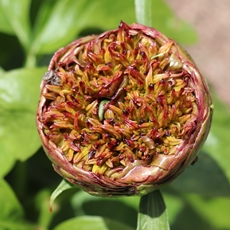
bud - "bullhead"
This typ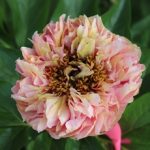 e of bud lacks bud covers and petals do not protect reproductive structures during formation. Since the interior of the flower is not protected from environmental factors (namely water & fungi) these buds often rot before opening. Double herbaceous hybrids are most prone to this, presumably due to having more petal mass. While this anomally is genetic, it may be expressed more commonly in certain environmental conditions. Hybridizers may want to avoid using plants expressing this trait, as offspring may continue to exhit the trait.
e of bud lacks bud covers and petals do not protect reproductive structures during formation. Since the interior of the flower is not protected from environmental factors (namely water & fungi) these buds often rot before opening. Double herbaceous hybrids are most prone to this, presumably due to having more petal mass. While this anomally is genetic, it may be expressed more commonly in certain environmental conditions. Hybridizers may want to avoid using plants expressing this trait, as offspring may continue to exhit the trait.

bud - flower
A floral bud containing reproductive structures of the plant. Refers to an unopened flower. Depending upon the cultivar, some peonies may grow side buds which most often bloom after the primary or main flower bud. In cutflower production side buds are often removed, which directs more energy in bud formation to the larger primary bud. Side buds are often smaller and express less doubleness in double formed flowers.

bud - vegetative (dormant bud)
A dormant bud containing plant structures which may grow into new stems, leaves and flowers in the coming growing season. These buds are produced on crown tissue in peonies. Often referred to as “eyes”. Peonies produce numerous vegetative buds, not all will become new growth/stems. Buds are most well developed in the fall of the season, but are present throughout the year in smaller, less obvious forms.
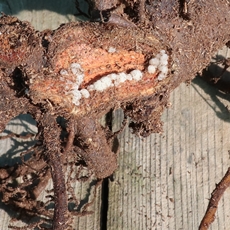
callus and callusing
A term used to describe the feature and process of in which peonies produce cellular growth to heal injured or cut roots and crown tissues. This can be compared to scar tissue formation in animals. Callusing allows in peonies allows roots to heal and become functional again. See “Heal and Healing”, related terms used in grafting woody peonies.
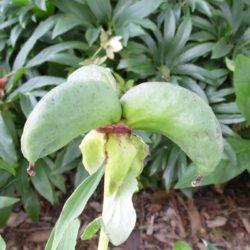
carpel(s)
The principal part of this organ is the ovary of the peony flower, a capsule protecting the ova, (eggs) leading to a pod bulging with seeds when ova are successfully fertilized. In peony flowers, carpels normally occur in clusters, but remain separate, not united (each is pollinated separately). Peonies may have 1 to 4 or more carpels.
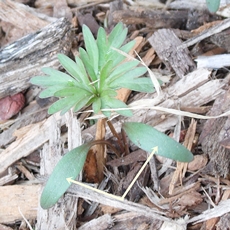
cotyledon (seed leaf)
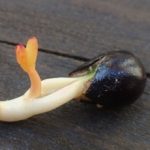 An embryonic leaf in seed-bearing plants, one or more of which are the first leaves to appear from a germinating seed. All peonies have cotyledons, but not seed leaves. In most peonies the cotyledon remain enclosed in the thick seed coat and serve as an energy/water reservoir for the developing seedling. Paeonia tenuifolia and certain indivuals from the Paeonia rockii complex commonly grow seed leaves from cotyledons.
An embryonic leaf in seed-bearing plants, one or more of which are the first leaves to appear from a germinating seed. All peonies have cotyledons, but not seed leaves. In most peonies the cotyledon remain enclosed in the thick seed coat and serve as an energy/water reservoir for the developing seedling. Paeonia tenuifolia and certain indivuals from the Paeonia rockii complex commonly grow seed leaves from cotyledons.

crown
A structure in peonies which is capable of producing both roots and vegetative buds. This structure often appears to be a widened area of root in which buds and roots are attached. Peonies are actually divided through crown division and not “root” division, as most roots are not capable of producing vegetative buds. Both herbaceous and woody peonies have crown tissue; woody peonies have stems which are a basic arial extension of the crown.
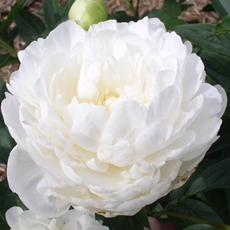
cultivar
A peony produced in cultivation which was selected for any of a number of traits. Cultivars are unique and must be propagated vegetatively to produce the same plant and flowers as the original (seeds from a given cultivar will not grow to become the same plant). Cultivars are usually identified by a specific name, which is unique. The APS Peony Registry contains registered peony cultivars.
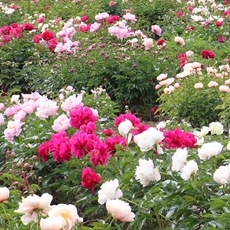
cultivar groups (Peony Registry)
APS, as the International Cultivar Registration Authority, makes use of 6 groups for registered cultivars of peonies. Taxonomists and other entities may use different groupings which suit their their needs specifically. The groupings are determined by information supplied by the registrant and is recorded by the registrar.
The following groups are recognized by APS for registered cultivars:
- Lactiflora Group
- Herbaceous Hybrids
- Suffruticosa Group (includes P. rockii hybrids)
- Lutea Hybrid Group
- Itoh Group & Intersectionals
- Species Selections
For further information click HERE
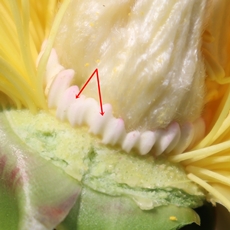
disk
A flower structure found at the base of the carpels. A disk may or may not be present, depending upon a cultivar’s genetic makeup. Disk structure is variable from cultivar to cultivar and may consistent of tiny projections, flattened surface or incomplete. Woody peonies do not have disks, but rather a sheath.
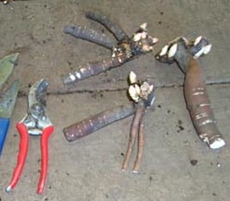
division
Division may be in reference to the practice of dividing, or a single propagule produced through dividing a plant. A progule (division) is made up of supporting roots, crown and dormant buds. Herbaceous peonies most often are propagated through division. Woody peonies may also produce divisions when adequate root and crown material is in proportion.

dormancy
The suspension of normal growth function by peony plants and seeds. This is often referred to as a resting state, but chemical changes are occuring in peonies during this period which are important to their growth.
Seeds in peonies have double dormancy. To break dormancy in peony seeds a period of warmth, then cold followed by warmth is required for growth.

eye(s)
See “bud – vegetative”
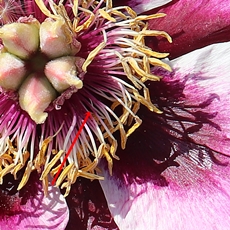
filament(s)
Stamens are made up of a pollen bearing anthers supported on small stems called filaments. A filament is sometimes
more than one color, with the lower portion (base) often darker than the upper half.
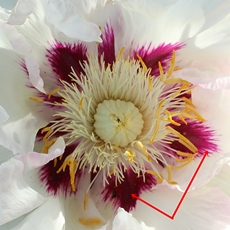
flare
An interior or upfacing marking found at the base of flower petals. Flares are most often associated with woody peonies, but may also be present in herbaceous peonies. Markings found on the outside of petals are known as bloctches – see blotch.

garden named
Naming of a peony which is not a registered cultivar. Typically “garden named” plants were grown from seed and given a name in the garden in which they were grown. These plants are sometimes available in commerce, but are not found in the International Cultivar Registry, which the APS maintains. Some hybridizers of new plants release garden named plants with no intention of registering them, thus they have no historical information for the general public to use. Garden named plants often cause problems in commerce, as buyers of these peonies will not have easily accessible information available. Since peonies live for a very long time garden named plants may also persist for many decades, causing identification problems long after they were named. Garden named plants are recognized as “seedlings” since they lack provenance.
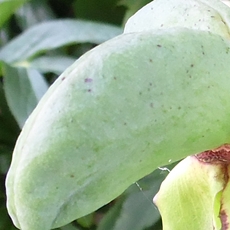
glabrous
Lacking hairs or smooth. Usually used to describe the characteristics of carpels in peonies which lack hairs.
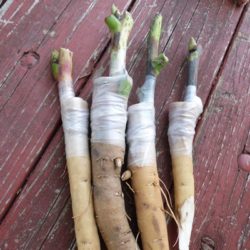
graft
The joined product of stem to root, as often seen in available woody peonies.
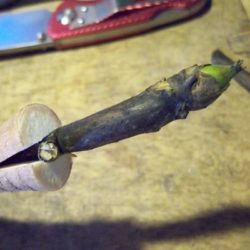
grafting
Commonly used process to propagate woody peonies, in which a scion (stem) is usually joined to a herbaceous peony’s root to produce a graft.
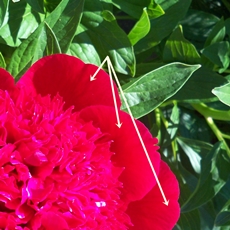
guard petal(s)
The large petals found at the base of a peony flower. These petals are often plate-like, but may be ruffled. Not all peonies express notable guard petals. Name “guard petal” as they protect the interior of the flower when closed or during formation.
Peony Glossary
Terms H-M
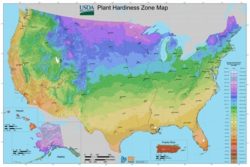
hardiness
Most peonies are hardy in USDA Hardiness Zones 3 to 8. However, these zones were designed with average low winter temperatures in mind and do not take into consideration numerous other variables. USDA zones were developed for plants with persistent above ground stems -most peonies will not be accurately accounted for in the system as all peonies have crowns and roots capable of new growth annually from the subsurface (includes woody peonies).
Water in the environment (includes ice), temperature variability, soil permeability, soil moisture and numerous other factors should be treated with equal importance when looking at hardiness. The zones should be used as a guideline, but not a rule. Link to larger USDA Hardiness Zone Map
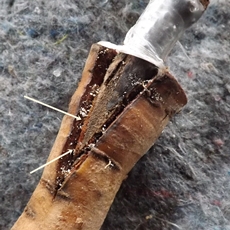
heal or healing
Also known as callus formation. A term that describes a period of time in which a graft’s scion joins through cellular growth to a nurse root. A period of 2 weeks at a temperature of approximately 75 to 82°F, in damp conditions are generally viewed as optimal healing conditions. Numerous methods and variation are used to attain proper healing. See grafting article for further information.
All peonies are capable of callus formation. Callus formation is a “healing” process which protects injured areas like those created by division or digging clumps. This type of growth could be compared to scare tissue formation in humans.
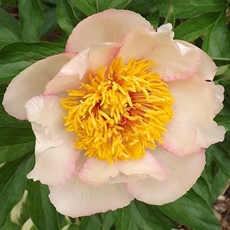
Herbaceous Hybrid (Registry Group designation)
These are herbaceous peonies which have more than one species in their ancestry. Some have pedigrees involving four or more species in their makeup. Typically stems carry one bloom, but sometimes more. Colors tend to be purer and more vibrant than in Lactiflora Group cultivars.
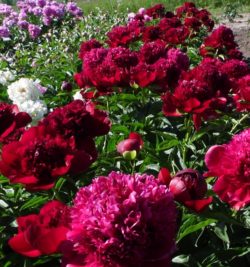
herbaceous peony
Any peony that produces annual growth and contains no woody parts above the soil surface. Herbaceous peonies grow new stems each spring after their period of dormancy (winter). Common garden peonies suchas, P. lactiflora cultivars are representative of this group.

intersectional peony
Any peony which arises from hybridization between two or more sections. This group commonly arises from a cross of plants from the taxonomic sections Moutan x Paeonia (woody peony x herbaceous peony).
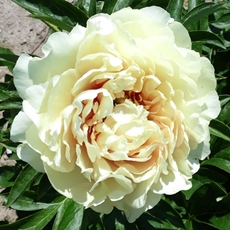
Itoh Group and Intersectionals (Registry Group desigination)
Itoh Group peonies are hybrids having Lactiflora Group peonies as a seed parent and Lutea Hybrid Group peonies as a pollen parent. The term “Intersectional” applies to crosses between two different sections of the genus and is thus a general descriptive term. Itoh applies to a specific cross as noted above. Features of most of these to date are woody peony-like foliage and flowers, with herbaceous plant habit.

Itoh peony
A group of peonies developed through selective breeding of (woody peony x herbaceous peony) or (herbaceous peony x woody peony). Itoh group peonies have characteristics of both herbaceous and woody peonies. In cold climates they are treated (grown) like herbaceous peonies – cut to the ground at the end of each growing season. See Itoh Peonies for further information.
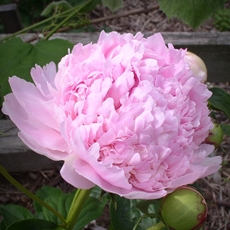
lactiflora
Paeonia lactiflora is a species originating from China and is a herbaceous type. Paeonia lactiflora was selectively bred for centuries in China and Europe, and more recently in the United States. Many cultivars are in commerce with highly variable characteristics. It is the most common garden peony and is prized as a cutflower .
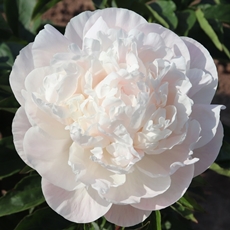
Lactiflora Group (Registry Group designation)
These are the common garden peonies descended from the Chinese herbaceous peonies. They are diploid in chromosome number. There are more cultivars of these than in any other group. Crosses between members of this group are not considered hybrids. Multiple blooms per stem almost always occur with plants in this group. As a group, they are latest to bloom. Also in this group are the “lactifloras of hybrid origin” which result from hybrids being crossed back to lactifloras to the point they become visually indistinguishable from them.

leaf
An annual structure in peonies. Leaves carry out the work of photosynthesis during the growing season. Leaves are collectively known as foliage.
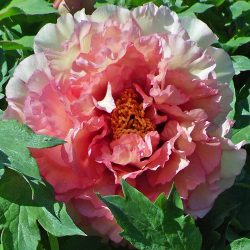
lutea hybrid
The name given to a group of woody peonies that originated from crosses of P. delavayi x P. suffruticosa. At one time the yellow form of P. delavayi was classified and named P. lutea. The lutea hybrids have the largest color variation of any group of peonies, P. delavayi being largely responsible. Woody peony cultivars with flowers having yellow pigmentation arise from this group.
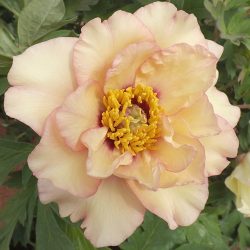
Lutea Hybrid Group (Registry Group designation)
These are woody peony (tree peony) cultivars originally derived by crossing between members of the subsection Delavayanae (P. delavayi, P. lutea, P. potaninii and P. ludlowii) as one parent, and members of the Suffruticosa Group as the other parent. Crosses within the Lutea Hybrids Group are also included.
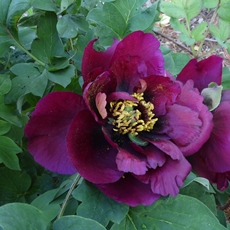
mutation
The changing of the structure of a gene, resulting in variation of expression in traits. Mutation can occur naturally or through man made  actions. Mutation may impact traits in many ways, some are detrimental, others may enhance a plant’s appearance, growth, etc… Mutations are most noticeable in flower color and form, but other traits are commonly altered, going unnoticed by the casual observer. Certain groups of peonies such as lutea and intersectional hybrids have noticeably more mutations, which is likely due to their divergent genetic backgrounds which are not completely compatible. At right is the lutea hybrid cultivar ‘Copper King’, showing a mutation to the right.
actions. Mutation may impact traits in many ways, some are detrimental, others may enhance a plant’s appearance, growth, etc… Mutations are most noticeable in flower color and form, but other traits are commonly altered, going unnoticed by the casual observer. Certain groups of peonies such as lutea and intersectional hybrids have noticeably more mutations, which is likely due to their divergent genetic backgrounds which are not completely compatible. At right is the lutea hybrid cultivar ‘Copper King’, showing a mutation to the right.
Peony Glossary
Terms N-S
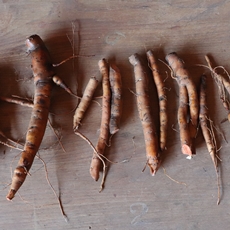
nurse root
Sometimes referred to as understock. A root used in the grafting procedure that serves as a temporary root system, until the scion or bud material produces ‘own roots’ from crown tissue. Commonly used to propagate woody peonies. Since woody peonies are not easily divided, the use of nurse roots in grafting is important in developing available stock. Nurse roots may become large vessels overtime and may need to be cut away if they interfere with own root development. Nurse roots are most often from P. lactiflora cultivars.

originator
Person who selected a cultivar. An originator may not be the hybridizer or registrant of a cultivar, but may be both when they have grown the seed and registered the cultivar.
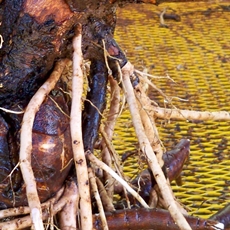
own root(s)
A term used to describe a grafted peony or any peony’s root system which is its own. Grafted plants often use P. lactiflora or another type of peony’s root as its initial root system. As a grafted plant grows older it will begin to develop roots from its own crown tissue. “Own roots” are genetically in tune with the plant they support and development of this type of root system is beneficial after establishment.
Own roots in woody peonies are narrow and long, while nurse roots are wide and tuberous.

perennial
Any plant, including peonies, which life cycle includes many years. In peonies, longevity can be hundreds of years if environmental factors are conducive for growth.

petal
Segments of the corolla of a flower, which are modified leaves and are typically colored. In peonies these may take on numerous forms: flat, ruffled, fluted, creased, spathulate, ovate, etc… The variation in form and color is responsible for the popularity of peony flowers in both the garden and vase.
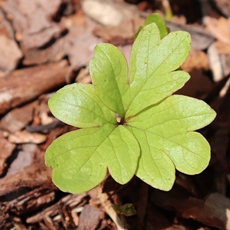
plumule
A leaf form seen in seedlings in their first year of growth. Peonies produce a single immature leaf form in their first season of growth, known as a plumule. Plumules are the only leaf produced during their first year of growth and often look nothing like the mature leaf form to be seen in successive years.
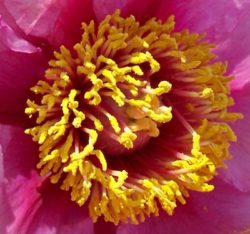
pollen
The male reproductive cells of plants. Pollen in peonies is yellow. Not all peonies produce pollen or viable pollen, thus not all may be used as male parents (commonly a problem with hybrids).
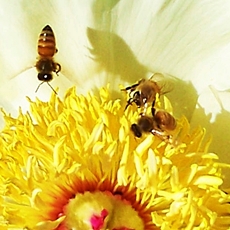
pollination
The transfer of pollen to a stigma to fertilize an ovule and produce seed. This may be accomplished naturally or through human hand pollination. Pollination is required to produce seed and the resulting offspring will not be true to their parents. Insects are the main natural pollinators of peonies. Ants, bees and many flies performation natural pollination duties.
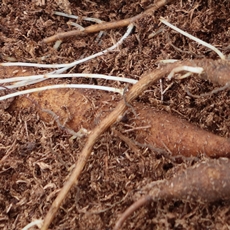
root

scion
A stem that includes buds used in grafting to join with a nurse root. The scion, meaning son or offspring of, is a duplicate of the donor plant and will grow to be a copy.

Seedling
A seedling is a peony grown from seed. Peonies grown from seed are not copies of their parents (they do not come true from seed), therefore seedlings may look quite different from their pollen and seed bearing sources. Seedlings may be selected for unique traits and then named and hopefully registered, which raises their level to a registered cultivar. See “Garden Named” for additional information.
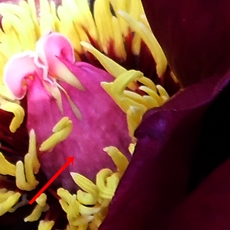
sheath
In tree peonies and hybrids between tree peonies and herbaceous peonies, the disk may be extremely well developed to
form the sheath, a papery covering enclosing the carpels. The sheath may be found in varying degrees of development
and should be recorded from observations of a newly opened flower.

species peony
A group of similar individual peonies capable of reproduction in nature. These are often referred to as ‘wild’ or ‘wild botanic species’, as they occur in nature without human intervention in their life cycles.
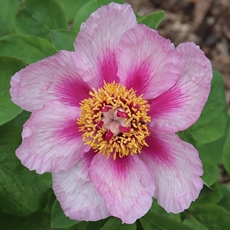
Species Selection (Registry Group designation)
Examples may be species selections from wild populations or those grown in the garden, which show characteristics desired for introduction into general cultivation.
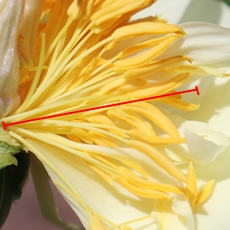
stamen
The structure in a flower which includes: filament, anther and pollen.

stem
The leaf and flower supporting structure in peonies. Herbaceous peonies produce annual stems and woody peonies produce semi-perennial stems. Stem structures can be highly variable (upright, spreading, branched etc…). Stems color is variable from cultivar to cultivar, some being very ornamental. Stems emerging from the ground in early spring are most often red, but may be other colors depending on genetic traits.

stigma
A female structure which serves as a receiving surface for pollen. In peonies, each carpel is tipped with stigmatic surfaces which are made up of two tiny ribbons. The surface has a variably sticky surface for receiving pollen.
Many cultivar stigmas are capable of receiving pollen before pollen in the same flower has matured. Stigmas in these same flowers then become inactive once own flower pollen has matured, thus disallowing self contamination. This is not true for all peonies, as some are self-fertile.
In a number of hybrids, stigmas are incomplete or absent. This is especially true in double form hybrids, in which stigmas have been converted to petals.
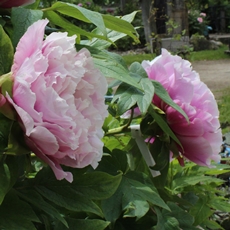
suffruticosa
A group of woody peonies including traditional Chinese and Japanese cultivars and other parts of the world. P. suffruticosa was once believed to be a species, but genomic studies have revealed they are hybrids involving species from the taxonomic subsection Vaginatae, which includes the following species: P. cathayana, P. decomposita, P. jishanensis, P. ostii, P. qiui and P. rockii. Flowers tend to be large and colors range from white, pink, red, lavender, purple and blends between these colors. Some have basal flares commonly associated with the species P. rockii. Plant habits, flower color and form are highly variable from one cultivar to the next. Yellow coloration in this group is not present, as this color originates from species found in the subsection Delavayanae (lutea hybrids). See Suffruticosa Group in the Peony Registry for specific cultivar information.

Suffruticosa Group (Registry Group designation)
The group includes the traditional Chinese and Japanese woody peonies (tree peonies), any of the purported Rockii Hybrids, and any other cultivars resulting from crosses within the subsection Vaginatae (P. decomposita, P. rotundiloba, P. rockii, P. ostii, P. jishanensis, P. qiui and P. cathayana). Subsection Vaginatae includes all woody species except those found in the subsection Delavayanae.
Peony Glossary
Terms T-Z
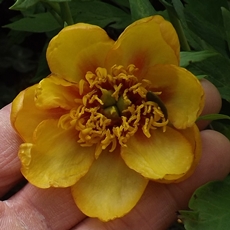
Taxonomic Groups
Peonies are divided into a number of taxonomic groups which assist in evaluating relationships between species. Commonly taxonomic groups are used by researchers, collectors and hybridizers working with peonies. See Taxonomic Classification of Peony Species.
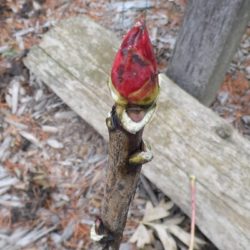
terminal bud
A term used to describe the location of a dormant bud on a woody peony’s stem. Terminal buds are the top most bud on the stem and are almost always the largest. These buds become more developed as the growing season progress and attain full size in August to September. The buds remain dormant during the winter season and contain the following year’s leaves and flowers. This type of budded stem is most desirable for grafting woody peonies due to their stored hormones and size.
tetraploid
See “Ploidy” in Hybridizing Glossary
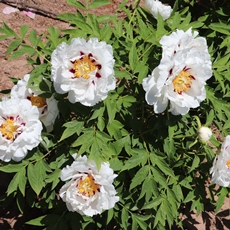
Tree Peony
See Woody Peony. Tree Peonies are correctly named woody peonies as the seldom attain “tree-like” stature. Typically a woody peony is sub-shrub in size, thus the name “tree peony” is a misnomer.
triploid
See “Ploidy” in Hybridizing Glossary
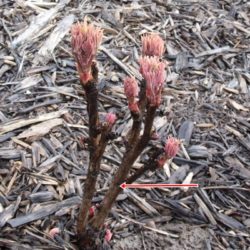
woody peony
Any peony that produces persistant perennial stems above the soil surface. Often, incorrectly termed “Tree Peony”. Includes woody species, suffruticosa hybrids and lutea hybrids. Woody peonies are a diverse group in both flower characteristics, foliage and plant habit. For further information see section in “LEARN” about woody peonies.
Peony Glossary
Hybridizing Terms

anther
A flower structure best described as an enlongated vessel which holds pollen. Found at the top of the filaments, they are often yellow in coloration are lance shaped. Some flowers do not have these structure – most often double form flowers.

asexual
Meaning reproduction without sex. This often refers to vegetative propagation. Division, tissue culture and grafting all produce identical plants through asexual reproduction. No pollen (male) or ovules (female) were involved to produce new plants.
Image: Herbaceous peony division

breeding lines
- Inbreeding: The practice of using related parents to produce offspring. This can be “selfing” see “cross”; or may use siblings or variety of closely related parents. In breeding may cause detrimental traits to accumulate in offspring, but can also serve to concentrate desired traits. Plants are less likely to show adverse impacts through inbreeding than animals.
- Line breeding: Often viewed as a form of inbreeding. This practice uses related plants to produce offspring, but may bring in outside genetics. Basically a breeding line is developed to accentuate desired traits.

carpel(s)
The principal part of this organ is the ovary of the peony flower, a capsule protecting the ova, (eggs) leading to a pod bulging with seeds when ova are successfully fertilized. In peony flowers, carpels normally occur in clusters, but remain separate, not united (each is pollinated separately). Peonies may have 1 to 4 or more carpels.

chromosome
The basic thread-like structure which are comprised of genes. See “ploidy’ for more information about chromosome configurations.

clone (clonal)
Genetically identical individuals.

cross - self (selfing)
Commonly known as self-pollination. A self cross is made through pollen from a cultivar being applied to the stigma found on the same cultivar. Thus a single cultivar serves as both male and female parent. This practice is the ultimate form of inbreeding, but may yeild interesting results through reshuffling of genes. Risks in this type of cross are concentration of defective or unbecoming traits, which the offspring may express. Positives are concentration of wanted traits and genes, and further expression of those.

cross - out (out cross)
An out cross simply uses two different parent cultivars, which are not closely related. Pollen collected from one cultivar is placed on the stigma of a completely different cultivar. A pure out cross would be the involvement of two completely unrelated cultivars, which may be difficult in the peony world as few plants in any group are completely unrelated. Out crosses typically create offspring with greater genetic and trait variability and are generally used to bring new traits into breeding lines.

cross - back (back cross)
A back cross uses offspring crossed back to its parent or grandparents. This type of cross is used to “fix” traits and create greater expression of a trait. It is a form of inbreeding.

cross - sib or sibling (sib cross)
A sib cross is one in which siblings are crossed with each other. Like the back cross, sib crosses are used to “fix” traits or create greater expression of a trait. Again another form of inbreeding.
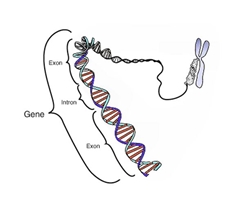
gene
Unit found within chromosomes which are transferred from a parent to offspring. Genes are the basic unit in heredity and are expressed as traits or may be held in a recessive state (no expression), dominant (always expressed), our may combine in numerous way to create an expression. Basically, genes are the codes which determine traits (characteristics). Simple Mendelian inheritance may be of assistance, but peonies often express many more complex genetic relationships.

genetic compatibility
Discussions of compatibility basically involves whether pollen (male cell of parent) can fertilize an ovule (female cell of a parent) to produce viable seed.
Genes, chromosomes, other structures and processes during cell formation in sexual reproduction (fertilization) may or may not be compatible. Differences in ploidy, or numbers of chromosomes, is often attributed to compatibility. However, parents having the same ploidy may or may not have compatibility due to any of a number of other differences. Peonies are highly complex in their reproductive processess, which can be quite fluid in different years, thus parental compatibility can be influenced.
Of importance may be chromosome size and gene loci (location). Parents with variable chromosomes, but having the same number of chromosomes may be unable to make needed pairings, thus are incompatible.

hybridizing - hybrid
Hybridizing is process which encompasses numerous disciplines in which different individuals of two different species or varieties are crossbred. Hybridizing is usually practiced for accurate purposes through hand pollination, but hybrids may be produced through open pollination. Typically, hybridizers systematically create purposeful crosses and are not reliant on open pollinated outcomes.
Some definitions of “hybrid” recognize that two different species are to be involved in a cross to make a hybrid; while others subscribe to the idea that hybrids may come from the same species with parents having different traits.
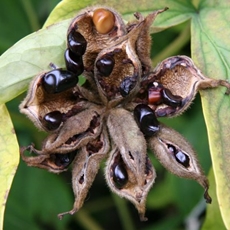
incomplete seed
Numerous peony cultivars produce incomplete seed, which may appear to be viable. These seeds often are missing the endosperm, embryo or have defects which prevent successful germination. Seeds may appear to have dents and creases, and quickly shrivel when dried a day or two. These seeds are not viable. Some cultivars produce oversized ova which encase themselves in a seed coat and are confused for viable seed.
Lutea hybrids, intersectional hybrids (Itoh group) and herbaceous hybrids are the most likely to produce incomplete seed, but species will also exhibit this behavior.

meiosis
A type of cell division found in sexually reproducing organisms. The process of meiosis begins with a normal diploid (or other chromosome configuration) cell and through division, daughter cells of haploid configuration are produced. A haploid cell, known as a gamete (sex cell), contains half the complement of chromosomes of a diploid cell. In peonies these cells are commonly called “pollen” and “ovule”. This is important for the fact that each haploid cell can combine with one of the opposite sex to create a completely new combination due to shuffling of chromosomes during mieosis. Production of a germ cell (beginning of a seed) through meiosis returns the ploidy to what was started with in its most basic form. Meiosis Chart (simplified).
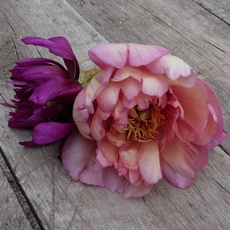
mutation
The changing of the structure of a gene, resulting in variation of expression in traits. Mutation can occur naturally or through man made actions. Mutation may impact traits in many ways, some are detrimental, others may enhance a plant’s appearance, growth, etc… Mutations are most noticeable in flower color and form, but other traits are commonly altered, going unnoticed by the casual observer. Certain groups of peonies such as lutea and intersectional hybrids have noticeably more mutations, which is likely due to their divergent genetic backgrounds which are not completely compatible. At right is the lutea hybrid cultivar ‘Copper King’, showing a mutation to the right.
A fairly high percentage of mutation or unpleasing gene expression is being seen in intersectional hybrids. These hybrids have lutea hybrids as parents (in most instances) which may be responsible for the greater incidence. Unfortunately, many of these mutated plants/flowers have less appealing traits.
Hybridizing with use of a plant showing mutations may be of interest to make use of a unique trait. However, it is not known whether these traits are actually transferred to the offspring. Example: The lutea hybrid ‘Black Forest’ produced the dark red mutation ‘Foreset Shadows’. ‘Black Forest’ is a cream flower with red highlights and dark flares.. All resulting offspring of ‘Forest Shadows’ have thus far shown no propensity for the dark coloration found in this mutation and appear to be the result of original plant.
Peonies with mutations are highly prone to further mutation themselves. Often these plants revert to their original forms or to something new and less desirable. Some mutations are more stable than others and may be cultivated as separate and unique plants, but hybridizing results using them as parents remains unknown.

ploidy (diploid, tetraploid, triploid & haploid)
Ploidy refers to the number of sets of chromosomes in cells. In theory, not always in practice, plants with the same ploidy are most likely to be fertile with each other.
Common ploides:
- Diploid: Individuals who’s cells contain two complete sets of chromosomes, one originating from each parent. Diploid is considered the basic configuration of chromosomes in most organisms.
- Triploid: Individuals who’s cells contain three sets of chromosomes, two originating from one parent and one from the other. Triploids, due to their uneven ploidy are often sterile (mule), as they are the result of parents with different numbers of chromosomes. This ploidy is common in F1 generation hybrids.
- Tetraploid: Individuals who’s cells contain double sets of chromosomes (twice what diploids do). Many hybrids are tetraploids.
- Haploid: Found in the form of a gamete or sex cell (pollen or ovule) is produced through the process of meiosis. A haploid cell contains half the complement of chromosomes found in normal ploidies. This configuration allows them to be combined (pollen gamete x ovule gamete) to create a zygote (first cell of a new organism and to produce aseed in peonies).
The impact of ploidy in hybridizing peonies is variable. Parents with different ploides may sometimes produce seed and produce fertile offspring. Fertility between plants with differing ploides may be due to production of pollen (or ovules) with different ploides, among other genetic abnormalities.

pollination (hand, open)
POLLENATION – HAND
The practice of collecting pollen and physically placing the chosen pollen on the stigmas of another or same plant. This practice insures known parents are used in a cross. A selective hybridizing practice, this crossing allows the hybridizer to determine traits which may be expressed in the offspring. While hand pollination does not promise any particular outcome, it does narrow possibilities. Numerous advances have been made through hand pollinations.
POLLINATION – OPEN
Flowers (stigmas) receive pollen by an unknown vector. Most commonly, bees, flies and ants carry pollen from one flower to another or move pollen within the same flower to the stigmas. In this scenario, only one parent is known (female parent). No parent selection is made when seeds are grown from this type of cross as parents are unknown. However, it could be said that selection was made by the act of growing resulting seed. This practice deals with unknowns, but many fine plants are produced from open pollination. Some would not consider this to be a hybridizing practice, but it does contain components thereof.

pollen
The male reproductive cells of plants. Pollen in peonies is yellow. Not all peonies produce pollen or viable pollen, thus not all may be used as male parents (commonly a problem with hybrids).
Pollen is ephemeral and must be protected from heat and sun. Pollen may be collected and dried for longer storage, but will only last a few days without refrigeration or freezing. Fresh pollen is most effective in making crosses.
Pollen which is light yellow may lack fertility. Some cultivars produce pollen sporadically over the years and close observation is required to determine pollen availability. Other cultivars (especially Japanese forms) may appear to have no pollen, however, with some additional effort anthers may be split to acquire small amounts useful in hybridizing.
A number of cultivars may produce pollen which has is not complete and lacks fertility, or may have viable pollen interspersed with non-viable pollen grains. The lutea hybrid, ‘Rosalind Elsie Franklin’ is an example of plant which produces approximately 20% viable pollen, which is highly fertile and successful crosses are numerous.

stigma
Stigmas are ribbon-like structures which serve to recieve pollen and rest atop each carpel.

